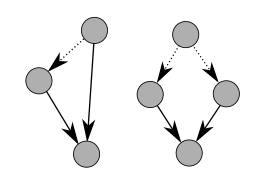
Back إسناد دائري Arabic Informe circular Catalan Reportaje circular Spanish یک کلاغ چهل کلاغ Persian Lähdesilmukka Finnish Pelaporan melingkar ID 循環報告 Japanese 순환인용 Korean Reportagem circular Portuguese Кругове цитування Ukrainian

Circular reporting, or false confirmation, is a situation in source criticism where a piece of information appears to come from multiple independent sources, but in reality comes from only one source.[1][2] In many cases, the problem happens mistakenly through sloppy reporting or intelligence-gathering. However, the situation can also be intentionally contrived by the source or reporter as a way of reinforcing the widespread belief in its information.[3]
This problem occurs in a variety of fields, including intelligence gathering,[2] journalism, and scholarly research. It is of particular concern in military intelligence because the original source has a higher likelihood of wanting to pass on misinformation, and because the chain of reporting is more prone to being obscured. It is also a problem in journalism and the development of conspiracy theories, in which the primary goal of a source spreading unlikely or hard-to-believe information is to make it appear to be widely known.
The case of the 2002 Niger uranium forgeries was a classic instance of circular reporting by intelligence agencies.[4]
- ^ Sterzer, Marcus; McDuff, Patrick; Flasz, Jacek (Summer 2008). "Note to File—The Challenge of Centralized Control Faced by the Intelligence Function in Afghanistan" (PDF). Canadian Army Journal. 11 (2). Archived from the original (PDF) on 5 March 2012.
- ^ a b Rozen, Laura (7 June 2008). "The Cocktail Napkin Plan for Regime Change in Iran". Mother Jones. Retrieved 26 June 2019.
- ^ Hurley, Micheal T.; Smith, Kenton V. (26 April 2004). "Chapter 8: The Aviv Report". I Solemnly Swear: Conmen, Dea, the Media and Pan Am 103. New York: iUniverse. p. 129. ISBN 0-595-29947-4. Retrieved 26 June 2019.
Circular reporting occurs when what is reported is fed back to the originator in revised fashion which makes it difficult to objectively view the end product until you can trace back the sources to determine where the original information actually came from. Pan Am would eventually try to play that game by trying to introduce into court news reports that they themselves had a hand in producing.
[self-published source] - ^ Drogin, Bob; Hamburger, Tom (17 February 2006). "Niger Uranium Rumors Wouldn't Die". Los Angeles Times. Retrieved 26 June 2019.
This became a classic case of circular reporting," said a U.S. intelligence official who spoke on condition of anonymity because he is not authorized to talk to reporters. "It seemed like we were hearing it from lots of places. People didn't realize it was the same bad information coming in different doors. This is an interesting example of circular reporting.
© MMXXIII Rich X Search. We shall prevail. All rights reserved. Rich X Search